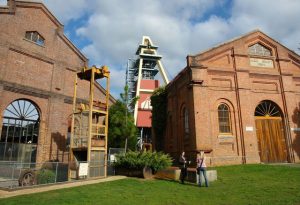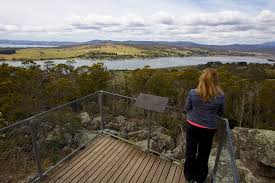From bushranger lookouts to gold mining hot spots. Discover the colonial history in Northern Tasmania with us!
The Lure of Gold – Beaconsfield.

The town of Beaconsfield was at it’s height, the third largest town on the island. Gold was discovered in the area in 1847, however the intensive mining did not kick off until late 1877.
“In 1903 an English company bought the Tasmanian Gold Mining and Quartz Crushing Company and formed the Tasmanian Gold Mining Company Ltd. The Company began extracting ore laden with gold from two shafts adjacent to each other, the Grubb and Hart Shafts. As flooding of the Tasmania Mine had become such a huge problem, ongoing capital was required to purchase and operate suitable dewatering and pumping equipment, some of which were ground breaking feats of engineering for the time. In 1904 – 5 engine houses were built for the Grubb and Hart Shafts and a central boiler house. These buildings now house the Beaconsfield Mine & Heritage Centre” – http://www.beaconsfieldheritage.com.au/
Did you know that Beauty Point was first established as a port to service the Beaconsfield gold mining? The town’s first wharf, where the deep water vessels first arrived, was once sitting where the Australian Maritime College now resides. Beauty Point Tourist Park is just a short stroll from the marina, home also to the Tamar Yacht Club.
The distance between Beauty Point and Beaconsfield by car will take just under 10 minutes. The Beaconsfield Mine and Heritage Centre offer tours revealing the rich history of the area, including the ‘Walk of Gold’; introducing you to the stories behind the mining history, through the people that lived there and interpretation of 15 buildings accessible on foot, the tour takes between 40 – 50 minutes to complete.
Climbing to Higher Ground – Brady’s Lookout.

Bushrangers and convicts – iconic to Australia as much as kangaroo’s and vegemite.
The Australian thriller ‘Van Diemen’s Land’, released in 2009, set in 1822 helped demonstrate the extreme wild bush land that covered Tasmania during that time, making life hard for all those that dared to call the place home.
“A bushranger’s life is wretched and miserable. There is a constant fear of capture and the least noise in the bush is startling. There is no peace day or night.” Matthew Brady Tasmanian bushranger, (1799 – 1826).
Brady’s Lookout is a unique attraction close to Beauty Point ( approximately 39 minutes), highlighting what was once the hideaway for the the infamous bushranger Matthew Brady (1799 – 4 May 1826), who also went by the title – ‘Gentleman Brady’ – for his reluctance to steal from women and his gentlemanly manners towards the fairer sex. With views up and down the Tamar river, Brady’s lookout made this a perfect location for a bushranger to take shelter. This tourist location now offers appropriate interpretation signage regarding the interesting bushranger history, along with ample parking, toilets and BBQ facilities.
If you are keen to discover more about the history behind Tasmanian bushrangers including a detailed timeline, head to: http://bushrangersau.blogspot.com.au/2012/07/tasmanias-bushrangers.html
The City of Launceston.

One of Australia’s oldest cities, Launceston has one of the best-preserved early cityscapes in Australia with its elegant Colonial and Victorian architecture and century-old parks.
“A valley formed by volcanic and glacier forces 10 million or more years ago… the Aborigine’s who lived here for some 40,000 years called it Kunermurleker and Ponmrabbel” – ‘A Walk in Old Launceston’ by Charles Wooley and Michael Tatlow, 2007.
Settled in 1806 by Europeans, Launceston is Tasmania’s second largest city and offers a wealth of interesting places to see and things to do for colonial history buffs.
The architecture in the city may well be the first point of call to view and appreciate; demonstrating Georgian, Regency, Victorian, Federation and Edwardian styles. Although certain streets are steep (eg. Balfour street notoriously so!), Launceston is easily accessible by foot.
If you head to Shield Street, many of the buildings date back to the 1830’s, including the second penitentiary, where convicts were bolted by the neck in public stocks and left for days. They were executed here too, by hanging from the gallows. This small street and surrounding area was important textile, grain and wool stores, along with smelters, pubs and breweries.
If heritage vehicles are more your thing, then perhaps start your visit at the National Automobile Museum of Tasmania. Located at 86 Cimitere Street, Launceston, showcasing a large vintage display of automobiles, motorcycles and memorabilia. Including an adjoined gift shop. Allow yourself a bit of time for this visit, there is more inside than meets the outside eye. For more information: http://www.namt.com.au/
The Inveresk Cultural Precinct is home to the former site of the railway workshops, where visitors can see the intact blacksmith shop and a ‘History of Rail in Tasmania’ at the Queen Victoria Museum and Art Gallery. For more information: http://www.qvmag.tas.gov.au/qvmag/?c=11&historyOnlineSearch=railway&searchFor=images&page=8
For further information on heritage walks and tours in Launceston:

